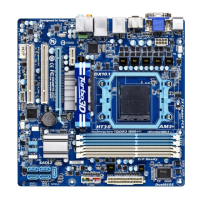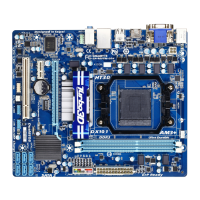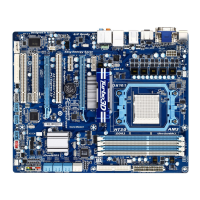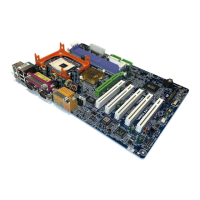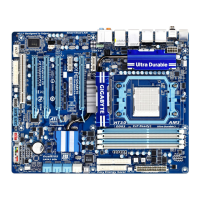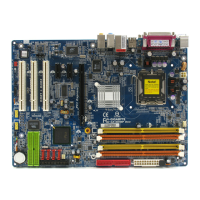
Do you have a question about the Gigabyte GA-880GM-UD2H and is the answer not in the manual?
| Memory voltage | 1.5 V |
|---|---|
| Number of memory slots | 4 |
| Maximum internal memory | 16 GB |
| Processor socket | Socket AM3 |
| Processor manufacturer | AMD |
| USB 2.0 connectors | 3 |
| Power fan connector | Yes |
| Number of SATA connectors | 5 |
| USB 2.0 ports quantity | 6 |
| Audio chip | Realtek ALC892 |
| Power source type | ATX |
| Motherboard chipset | AMD 880G |
| Audio output channels | 7.1 channels |
| Motherboard form factor | micro ATX |
| Compatible operating systems | Windows 7/Vista/XP |
| PCI slots | 2 |
| Networking features | 10/100/1000 |
| Width | 244 mm |
|---|
Explains different types of documentation provided by GIGABYTE for the product.
Guides users on how to find the revision number of their motherboard.
Safety procedures and guidelines to follow before installing hardware components to prevent damage.
Detailed technical specifications of the motherboard, including CPU, memory, I/O, and expansion slots.
Step-by-step guide on how to correctly install the CPU and its corresponding cooler onto the motherboard.
Instructions for installing memory modules, including dual-channel configuration and proper socket placement.
Procedure for correctly installing expansion cards into the available PCI Express or PCI slots.
Guide to setting up the ATI Hybrid CrossFireX technology by combining onboard and discrete graphics.
Description and function of all connectors and ports located on the motherboard's back panel.
Details and pin assignments for various internal connectors on the motherboard for system components.
Overview of the screens that may appear during the computer boot process, including function keys.
Explanation of the BIOS Setup main menu, navigation, and function keys for accessing options.
Allows fine-tuning of CPU clock, frequency, and voltages for advanced users.
Configuration of system date, time, IDE/SATA devices, floppy drive, and halt-on settings.
Settings for CPU power saving, virtualization, boot priority, and display initialization.
Enables/disables onboard devices like SATA controller, LAN, and audio.
Configures ACPI sleep states, power button behavior, and wake-up events.
Manages Plug and Play (PnP) and PCI slot IRQ assignments for hardware compatibility.
Monitors system temperatures, voltages, fan speeds, and hardware thermal control.
Loads the safest and most stable BIOS default settings for system operation.
Loads the optimal BIOS default settings for peak system performance.
Allows setting supervisor or user passwords to protect BIOS and system access.
Saves current BIOS settings to CMOS and exits the BIOS Setup program.
Exits the BIOS Setup program without saving any changes made.
Procedure for installing chipset drivers using the GIGABYTE driver disk and Xpress Install.
Information on installing GIGABYTE utilities and free software from the driver disk.
Accessing GIGABYTE application guides and motherboard manuals from the driver disk.
Provides contact details and website links for GIGABYTE headquarters and branch offices.
Displays basic system information such as BIOS version and OS information.
Links to GIGABYTE's website for downloading the latest BIOS, drivers, and applications.
Provides quick links to install GIGABYTE's latest developed utilities.
Utility for quick system data backup and restoration, supporting NTFS, FAT32, and FAT16.
Tools for updating the system BIOS using Q-Flash or @BIOS utilities, with DualBIOS protection.
Interface for fine-tuning system settings, overclocking, and monitoring hardware in Windows.
Revolutionary technology for unparalleled power savings and enhanced power efficiency.
Convenient tool for sharing data with computers on the same network via LAN connection.
Quickly create backups of changed data files or copy files from a specific backup.
Enables system power savings via Bluetooth cell phone proximity detection.
Steps to install, configure SATA controller mode, and set up RAID arrays for hard drives.
Guides for setting up multi-channel audio configurations and configuring microphone recording.
Instructions for installing and configuring S/PDIF In and Out cables for digital audio transmission.
Enables enhanced audio playback for stereo content, transforming it into multi-channel audio.
Steps to connect, configure, and adjust settings for microphone recording using HD Audio Manager.
Instructions on how to record audio using the Sound Recorder application and play back recorded sound.
Frequently asked questions and answers to common hardware and BIOS setup issues.
A step-by-step guide to diagnose and solve common system startup problems.
Information on RoHS, WEEE directives, and environmental compliance for the product.
